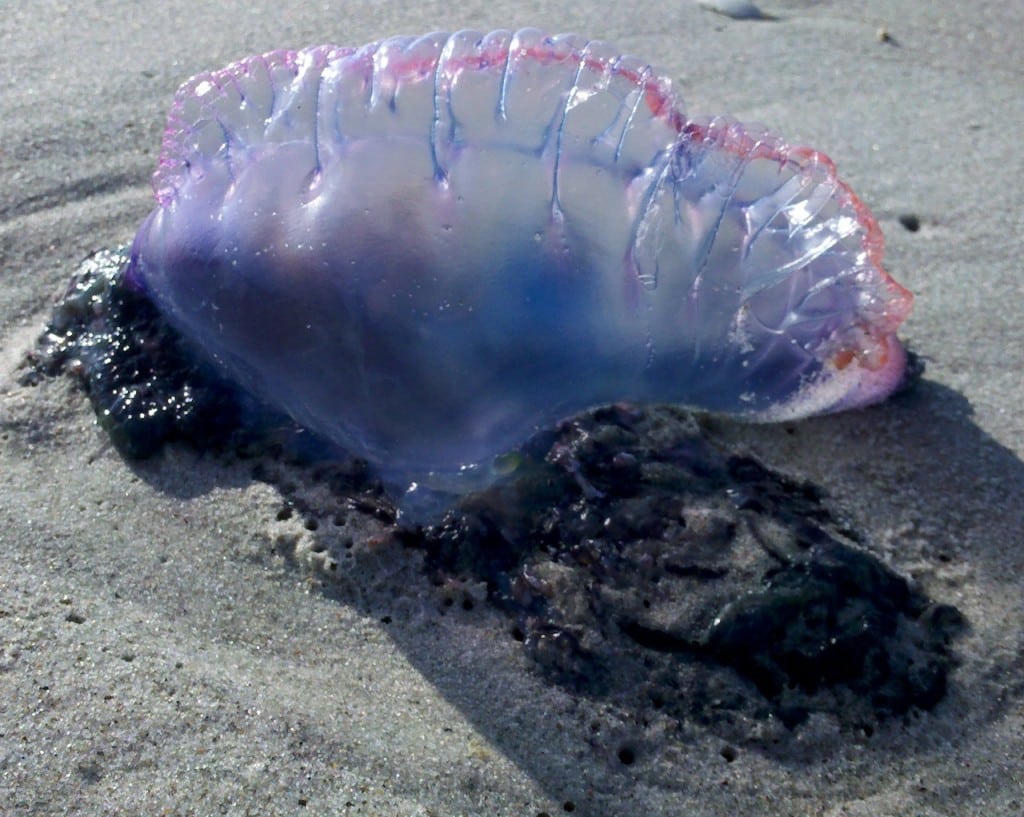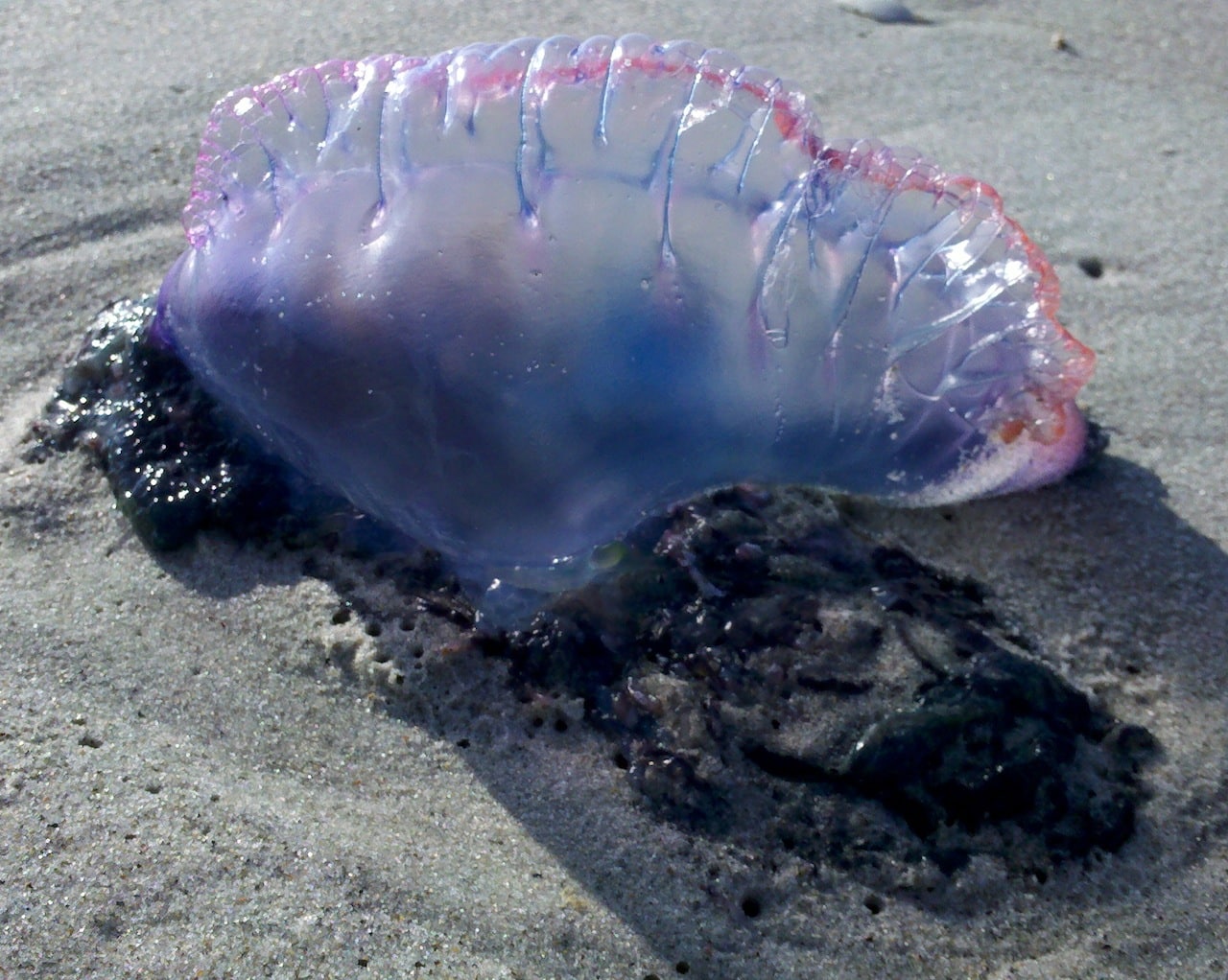• by Dr. Sarah D. Oktay, Managing Director UMass Boston Nantucket Field Station •

Man-of-wars have a multicolored (blue, red, purple, pink and mauve) balloonlike float called a pneumatophore, with tentacles that can hang down to 50 meters (although 30 feet or 10 meters is more common). Portuguese man-of-wars are not jellyfish, but instead are a colonial animal composed of polyps and medusoid individuals called zooids. There are four specialized zooids that when put together form the creature which is known as a siphonophore (Order Siphonophora; Class Hydrozoa). The Portuguese Man O’ War is named for its air bladder, which looks similar to the sails of the Portuguese fighting ship (Man of war) Caravela redonda of the 14th and 15th centuries. The medusa-form body consists of a translucent, jellylike, gas-filled float, which may be 3 to 12 inches long. Polyps beneath the float trail tentacles up to 165 feet long. Nematocysts on some polyps paralyze fish and other prey. Other polyps then attach to, spread over, and digest the victim (Yum). Man o’ wars can deliver a very serious sting and it is not uncommon to have the tentacles wrap around your entire body. Some kinds of jellyfish and our buddy the PMOW can also still sting while washed up on shore because the nematocyst “trigger” has not fired yet; so be sure to avoid them dead or alive. I was happy to know that both Clean Teamers who picked up the long dead creatures were okay.
The Portuguese man-of-war floats on the surface of tropical, marine waters. Generally, these colonies live in warm tropical and subtropical water such as along the Florida Keys and Atlantic coast, the Gulf Stream, the Gulf of Mexico, the Indian Ocean, the Caribbean Sea, and other warm areas of the Atlantic and Pacific oceans. They are especially common in the warm waters of the Sargasso Sea. They become entrained into the Gulf Stream as it rockets up along the East Coast and then spin off in warm core eddies (whirlpools which contain creatures and water from the Gulf Stream) that make their way up the Atlantic coast to the southern shores of Nantucket. This web site: http://www.geol.sc.edu/cbnelson/eddy/eddy.htm has a great explanation of warm core and cold core eddies (which would require an entire article) and an animation of how they move up the coast. Portuguese man-of-wars sometimes accumulate in large groups with several hundred bobbing together. They have no independent means of propulsion and either drift on the currents or catch the wind with their pneumatophores which are also called a sail. The sail sticks up sometimes 6-12 inches above the surface and are primarily filled with carbon monoxide although they also contain oxygen, nitrogen, carbon dioxide (tiny bit), and argon which diffuses from the atmosphere into the “balloon”. To avoid threats on the surface, the PMOW can use a small siphon to deflate their air bags and briefly submerge which is a pretty cool trick for basically something akin to floating coral.
This is a little early to be seeing PMOW this year and I’ll be checking out the temperatures and weather patterns and most importantly the changes in the Gulf Stream to see if there are any similarities to the summer of 2006. Why? In a rare occurrence in the summer of 2006, hundreds of Portuguese man-of-war showed up on southern Nantucket beaches, which prompted the temporary closing of many popular swimming beaches. In many parts of the country, a blue flag is used at lifeguarded beaches to indicate that there is a marine wildlife danger such as large quantities of PMOW or jellyfish (the most common)or sting rays in swimming areas. Although a few individuals can float into our waters, such a large influx can usually be contributed to a shift in the Gulf Stream. Unfortunately, as ocean waters warm world-wide and the populations of their natural predators decline, the occurrence and number of jellyfish are on the rise. Fortunately, our colder waters keep many of the extremely painful species relatively far from our beaches, although a few interlopers sneak in.
Jellyfish are the most primitive of the multicellular organisms. Most species are unable to swim on their own and they are considered large planktonic creatures influenced primarily by tides and currents and therefore tend to drift into swimmers or pose a problem when you swim into them. They are not deliberately drawing closer and closer to you in the water. Their effective defense and offense are the stinging capsules contained within cells called cnidocytes located along the tentacles. These cells act as a trigger with a toxin “bullet” inside the cnidocyte. Thankfully, many of the smaller species cannot pierce human skin or produce enough of a sting to affect us. They concentrate their stunning power on smaller fish, plankton, and sometimes each other. In a way, jellyfish can “hunt,” feeling their way along the ocean currents, using rudimentary light and pressure sensors to detect victims, and silently dispatching their dinners. Typically only when they become a nuisance or a danger do we become aware of them. To find out more about some of the species (moon jellies, comb jellies, very occasionally stinging sea nettle and lion’s mane) we see in Nantucket waters, check out my earlier article at http://www.yesterdaysisland.com/2008/features/18c.php.
Jellyfish and PMOW do contribute to science too. One type of jellyfish, the dime sized jellyfish known as Turritopsis nutricula, has been observed to reverse the aging process and turn back into its juvenile form when resources are scarce http://singularityhub.com/2011/04/25/immortal-jellyfish-provides-clues-for-regenerative-medicine/. The ability of some cnidarians to exhibit bioluminesce has led doctors to inject proteins derived from luminous jellyfish cells into human cancer cells to make it easier to spot them and treat them. http://www.bbc.co.uk/news/uk-england-york-north-yorkshire-11667447. This process is based upon the green fluorescent protein (GFP) discovered by American chemist Dr. Roger Y Tsien, who won a Nobel Prize in 2008 for taking luminous cells from the crystal jelly species of jellyfish and isolating the GFP. And the “venom” or toxins included in the stinging cells are being studied for their applications in treating heart ailments (http://www.smh.com.au/news/National/Jellyfish-venom-may-become-medicine/2006/11/06/1162661606416.html)
But these PMOW don’t just float around looking pretty, they also serve as food for several creatures. Loggerheads turtles eat PMOW as do ocean sunfish (Mola mola) although sunfish prefer jellyfish like moon jellies. The resemblance of these siphonophores to Mylar balloons is one of the reasons why people should not use helium balloons. Turtles and other creatures deliberately eat balloons thinking they are getting a PMOW or jellyfish snack and necropsies on these animals often reveal a stomach full of plastic balloons. Some fish hang out within a PMOW curtain of tentacles for protection. A small fish, Nomeus gronovii (the man o’ war fish or shepherd fish), is partially immune to the poison from the stinging cells and can live among the tentacles. It seems to avoid the larger, stinging tentacles, but feeds on the smaller tentacles beneath the gas bladder. The PMOW is often found with a variety of other marine fish, including clownfish and yellow jack. The clownfish can swim among the tentacles with impunity, possibly owing to their mucus, which does not trigger the nematocysts. All of these fish benefit from the shelter from predators provided by the stinging tentacles, and for the PMOW the presence of these species may attract other fish to feed on. This is an excellent example of mutual commensalism and symbiosis
But we don’t have that mucus layer (I hope), so what do you do when stung by a PMOW? Remedies for jellyfish stings include applying a cold pack or ice to slow the spread of toxin or applying hot water to break down the toxins. While working the Portuguese Man O’ War dense waters off of Galveston, I usually carried a container of Adolph’s meat tenderizer which contains an enzyme similar to papain to break down the proteins in the toxins. You do not want to use fresh water to wash the affected area, always use salt water, then warm salt water. Fresh water usually makes things much worse. For other types of true jellyfish stings, you can clean the area with rubbing alcohol, ammonia, vinegar or urine (yes, you read right), but none of those work as well as simple salt water and then 15 minutes later, a hot water rinse.
For the wordsmiths out there, washed up on the shore creatures are neither flotsam nor jetsam. Flotsam is the floating wreckage of a ship or its cargo. Jetsam is part of a ship, its equipment, or its cargo that is purposefully cast overboard or jettisoned to lighten the load in time of distress and that sinks or is washed ashore. For the artists out there, Wired magazine recently featured photographer Aaron Ansarov who took pictures of man-of-wars arranged in various groupings on top of a light table, and mirrored the images to turn them into kaleidoscopic shapes that can resemble alien figures, precious gems, and terrifying landscapes. He returns the creatures back to the seaside beach near his home in Delray Beach, Florida after their photo shoot (http://www.wired.com/rawfile/2013/04/aaron-ansarov-man-of-wars/). The pictures are very surreal and beautiful, even psychedelic.
Portions of this article were previously published in the August 28th2008 issue of Yesterday’s island located at http://www.yesterdaysisland.com/2008/features/18c.php. You can find out about the other common jellyfish found here in that article. Photo source and creative commons attributions and share alike credit http://commons.wikimedia.org/wiki/File:Portuguese_Man_o’_War_-_Pine_Knoll_Shores,_NC_05-29-11.jpg ).



